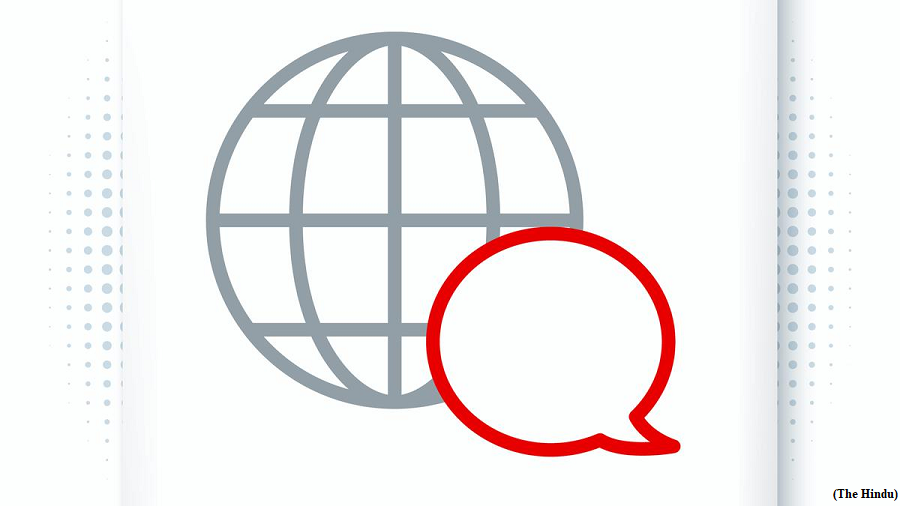Disappearing languages, vanishing voices (GS Paper 1, Culture)

Context:
- English as a common language in India has been acting as a thread by connecting multilingual Indians since the time of the British Raj.
- English as a common language of the world would strengthen power as a united human force.
A forecast of language extinction:
- An estimated 7,000 distinct languages are spoken as a mother tongue across the world. But these languages are shrinking rapidly. An interesting mathematical model published in The Economic Journal which forecasts the extinction of 40% of languages with less than 35,000 speakers within 100 years.
- By extinction it is meant that the languages will no longer be spoken as a mother tongue, or as the principal language. In essence, the diversity of languages is shrinking with time.
- Mother tongues of about half the people in the world belong to a pool of 10 most spoken languages; language diversity faces a grave threat. Today, English is the most widely spoken language of the world. British colonial rule helped spread the language.
Role of migration:
- This shrinking in the diversity of languages and their extinction are also related to the migration of people to countries which have a common language.
- When people migrate, there is pressure to shift to the dominant language spoken in the country where they live in order to capitalise on the social and economic advantages offered by the new place.
- In the process, first-generation migrants become bilingual, the next generation has a weaker grasp of its mother tongue, and the third generation may no longer speak or understand their grandparents or great-grandparents at all.
- India is a good example with increasing migration to English-speaking countries. English now has 340 million native speakers and more than 1.2 billion second language speakers, with much scope for further growth.
Language Diversity Index:
- The Index of Linguistic Diversity (ILD), which was introduced to quantitatively understand the trends over the past 30 years in the number of mother-tongue speakers of the world’s languages, is a measure to gauge the decline of languages.
- There is also a Language Diversity Index, where the probability that two people selected from a population at random will have different mother tongues; it ranges from 0 (everyone has the same mother tongue) to 1 (no two people have the same mother tongue).
- Obviously, countries that have people with a smaller number of mother languages have a lower LDI than countries with a large number of mother tongues.
- For example, the United Kingdom has an LDI of 0.139 when compared to 0.930 for India. The predominant language in the United States is English as in the United Kingdom, due to the significant presence of migrants from different countries, the LDI of the U.S. is 0.353.
- In terms of LDI, the three lowest ranking countries are Haiti (0.000), Cuba (0.001) and Samoa (0.002), while the top ranking three countries are Papua Guinea (0.990), Vanuatu (0.972) and the Solomon Islands (0.965).
- The ILD demonstrates that globally, linguistic diversity declined by 20% over the period 1970-2005. Regionally, indigenous linguistic diversity declined over 60% in the Americas, 30% in the Pacific including Australia and almost 20% in Africa.
Key observations:
- The index actually tries to understand the distribution of speakers among all the spoken languages of the world. It has been found is that the distribution is becoming greatly uneven with the passage of time.
- A greater number of people in the world are transitioning to just a few dominant languages at the expense of several smaller ones, resulting in a loss of linguistic diversity, where, finally, some of the languages are becoming extinct.
- Dozens of languages today have only one living native speaker, which shows how precariously placed some languages are. Once they vanish, an identity and culture also vanish.
- The extinction of languages will only result in shrinking cultural diversity and an increase in cultural homogenisation.
Way Forward:
- According to a report published by UNESCO in 2018, 42 languages are heading towards extinction in India. These were spoken by less than 10,000 people.
- According to the norms set by UNESCO, any language spoken by only 10,000 people is potentially endangered. Most dying languages are from the indigenous tribal groups spread across India.
- Any loss of language is not only a loss of linguistic diversity but also a loss in terms of associated cultural variations, opinions, views and knowledge. It is time to evolve ideas to arrest the decline of languages on the larger global canvas.
- The world must at least try to find ways and means to preserve some of its endangered languages.


